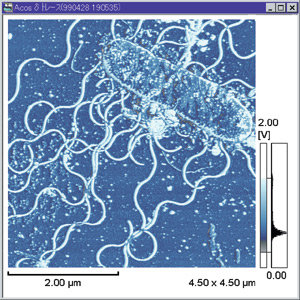Vibrio alginolyticus
Classification
Higher order taxa
Bacteria; Proteobacteria; Gammaproteobacteria; Vibrionales; Vibrionaceae; Vibrio
Species
|
NCBI: Taxonomy |
Vibrio alginolyticus
Description and significance

Organisms from the Vibrio genus were first observed by Filippo Pacini in 1854, and were further described by Robert Koch in 1883. The species V. alginolyticus emerged on the scene as a result of the need to further classify another Vibrio species, Vibrio parahaemolyticus. V. parahaemolyticus historically had included two biotypes, but it was suggested by Zen-Yoji et al. in 1965 to make the second biotype into its own species. In 1968, Sakazaki et al. proposed a new name for the biotype species: Vibrio alginolyticus. V. alginolyticus would later be isolated in 1997, as a result of a pathogenic outbreak in Russia. 2, 3
V. alginolyticus can be “comma” or coccoid shaped and is Gram negative. 1 There are a few different strains, many are pathogenic, and the bacteria has been imaged displaying many lateral flagella.
(For more information, see: Vibrio).
Genome and genetics
a. To what major branch of the prokaryotes do they belong? (see textbook or Bergey’s). List 2-3 closely related but separate species or genera of bacteria.
b. Briefly describe any extra-chromosomal elements or genetic tools that are used to study the bacterium: viruses, plasmids, transposons that allow genetic manipulation and analysis.
c. Has the genome or genomes been sequenced? If so, include the website for the database and one or two highlights of the genome. Also indicate genome size (base pairs), %G+C (nucleotide base composition) and number of genes, and specific genes or gene regions that are unique to this organism. If it has not been sequenced, give its closest relative that has been sequenced, its website, and some general information about the related sequence.
Example: The sequence of Haemophilus influenzae was determined using whole genome shotgun sequencing (Fleischmann et al. 1995).
Nutrition and metabolism
a.Describe the growth characteristics of your bacterial species; sources of C, N, electrons; respires/ferments, uses O2, etc.
b.What kinds of culture conditions (temp, pH, media) are needed for laboratory study?
c.What kinds of waste, by-products, volatile compounds are generated?
Ecology / Pathology
Ecology: How is your microorganism important in the ecosystem where it is found? How does it impact other organisms in the environment (could be positive or negative impact)?
Pathology: How does the microbe cause disease as it interacts with the host? Describe any specific toxins or pathways that are used for invading and causing disease in the host. What treatment is used to inhibit or kill the microbe?
Current Research
Describe recent research and findings that have been done with this organism. The research can be clinical, applied or basic research. This section should be based on 2 recent papers (10 years or less) and summarized in your own words.
References
1. lbertini MC, Accorsi A, Teodori L, Pierfelici L, Uguccioni F, Rocchi MBL, Burattini S, Citterio B. Use of multiparameter analysis for Vibrio alginolyticus viable but nonculturable state determination. Cytometry. 2006;69A:260–265.
2. Mustapha S, Mustapha EM, Nozha C. Vibrio Alginolyticus: an emerging pathogen of foodborne diseases. Int J Sci Technol. 2013;2(4):302-309.
3. Smolikova LM, Lomov LM, Khomenko TV, Murnachev GP, Kudriakova TA, Fetsailova OP, Sanamiants EM, Makedonova LD, Kachkina GV,
Golenishcheva EN. Studies on halophilic vibrios causing a food poisoning outbreak in the city of Vladivostok. Zh Mikrobiol Epidemiol Immunobiol. 2001;6:3-7.
Authored by Parker Morris, a student of CJ Funk at John Brown University
